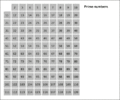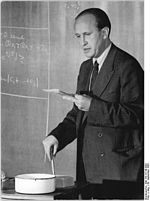Sieve theory is a set of general techniques in number theory, designed to count, or more realistically to estimate the size of, sifted sets of integers...
14 KB (2,359 words) - 17:04, 3 August 2024
In mathematics, the sieve of Eratosthenes is an ancient algorithm for finding all prime numbers up to any given limit. It does so by iteratively marking...
24 KB (3,042 words) - 00:45, 15 August 2024
In number theory, the fundamental lemma of sieve theory is any of several results that systematize the process of applying sieve methods to particular...
6 KB (961 words) - 10:48, 4 August 2022
In number theory, the parity problem refers to a limitation in sieve theory that prevents sieves from giving good estimates in many kinds of prime-counting...
11 KB (1,966 words) - 20:29, 4 January 2022
numbers in number theory, any of a variety of methods studied in sieve theory in combinatorics, the set of methods dealt with in sieve theory or more specifically...
476 bytes (98 words) - 15:14, 9 May 2019
The large sieve is a method (or family of methods and related ideas) in analytic number theory. It is a type of sieve where up to half of all residue...
6 KB (863 words) - 20:33, 23 March 2024
the Legendre sieve, named after Adrien-Marie Legendre, is the simplest method in modern sieve theory. It applies the concept of the Sieve of Eratosthenes...
3 KB (645 words) - 05:39, 20 April 2022
Hans-Egon Richert (section Sieve methods)
worked primarily in analytic number theory. He is the author (with Heini Halberstam) of a definitive book on sieve theory. Hans-Egon Richert was born in 1924...
5 KB (443 words) - 06:50, 6 May 2024
In category theory, a branch of mathematics, a sieve is a way of choosing arrows with a common codomain. It is a categorical analogue of a collection of...
6 KB (771 words) - 07:29, 28 April 2024
conceptual basis in number theory. It is especially suited to quick hand computation for small bounds. Whereas the sieve of Eratosthenes marks off each...
21 KB (3,287 words) - 03:02, 2 September 2024
number theory, for example, sieve theory, are better covered by the second rather than the first definition: some of sieve theory, for instance, uses little...
86 KB (10,832 words) - 05:49, 3 October 2024
Goldston-Pintz-Yıldırım sieve (also called GPY sieve or GPY method) is a sieve method and variant of the Selberg sieve with generalized, multidimensional sieve weights...
8 KB (1,825 words) - 12:53, 24 August 2024
In the field of number theory, the Brun sieve (also called Brun's pure sieve) is a technique for estimating the size of "sifted sets" of positive integers...
5 KB (913 words) - 21:22, 14 March 2023
Eduard Sievers developed a theory of the meter of Anglo-Saxon alliterative verse, which he published in his 1893 Altgermanische Metrik. Widely used by...
2 KB (255 words) - 23:28, 13 April 2023
Brun's theorem (category Sieve theory)
Viggo Brun in 1919, and it has historical importance in the introduction of sieve methods. The convergence of the sum of reciprocals of twin primes follows...
10 KB (1,263 words) - 03:43, 3 October 2024
In number theory, the Selberg sieve is a technique for estimating the size of "sifted sets" of positive integers which satisfy a set of conditions which...
5 KB (707 words) - 20:04, 22 July 2024
List of lemmas (section Sieve theory)
approximation) Hua's lemma Vaughan's lemma Bhaskara's lemma Fundamental lemma of sieve theory Borel–Cantelli lemma Doob–Dynkin lemma Itô's lemma (stochastic calculus)...
8 KB (524 words) - 11:06, 2 August 2024
sieve with reduced real time expended for a given large practical sieving range. Sieve of Eratosthenes Legendre sieve Sieve of Sundaram Sieve theory A...
14 KB (1,995 words) - 09:15, 23 May 2024
Lucky number (section The sieving process)
In number theory, a lucky number is a natural number in a set which is generated by a certain "sieve". This sieve is similar to the sieve of Eratosthenes...
8 KB (787 words) - 03:30, 27 September 2024
field sieve Large sieve Quadratic sieve Sieve of Atkin Sieve of Eratosthenes Sieve of Sundaram Sieve of Pritchard Sieve, in medicine, a "surgical sieve" refers...
2 KB (334 words) - 12:50, 23 April 2024
number theory Mahler's theorem Brun sieve Function field sieve General number field sieve Large sieve Larger sieve Quadratic sieve Selberg sieve Sieve of...
10 KB (937 words) - 23:04, 14 September 2024
In number theory, the general number field sieve (GNFS) is the most efficient classical algorithm known for factoring integers larger than 10100. Heuristically...
13 KB (1,768 words) - 21:32, 26 September 2024
number theory, the larger sieve is a sieve invented by Patrick X. Gallagher. The name denotes a heightening of the large sieve. Combinatorial sieves like...
3 KB (396 words) - 00:43, 18 June 2023
In mathematics, the sieve of Sundaram is a variant of the sieve of Eratosthenes, a simple deterministic algorithm for finding all the prime numbers up...
9 KB (1,368 words) - 04:26, 17 June 2024
2019) was an American mathematician who pioneered large sieve theory and invented the larger sieve. Patrick Ximenes Gallagher was born on January 2, 1935...
9 KB (781 words) - 06:55, 6 May 2024
Mertens' theorems (category Summability theory)
elementary solutions Vol 2, problems 171, 173, 174 Weisstein, Eric W. "Mertens Constant". MathWorld. Varun Rajkumar, π(x) and the Sieve of Eratosthenes...
7 KB (1,347 words) - 22:03, 11 July 2024
twin brothers. Iwaniec studies both sieve methods and deep complex-analytic techniques, with an emphasis on the theory of automorphic forms and harmonic...
10 KB (861 words) - 17:55, 23 November 2023
In number theory, the Turán sieve is a technique for estimating the size of "sifted sets" of positive integers which satisfy a set of conditions which...
3 KB (509 words) - 20:03, 22 July 2024
to 1 in many programming languages. In lambda calculus and computability theory, natural numbers are represented by Church encoding as functions, where...
30 KB (3,123 words) - 13:43, 2 October 2024
elements. Also in set theory, 0 is the lowest ordinal number, corresponding to the empty set viewed as a well-ordered set. In order theory (and especially its...
75 KB (8,230 words) - 00:56, 22 September 2024







